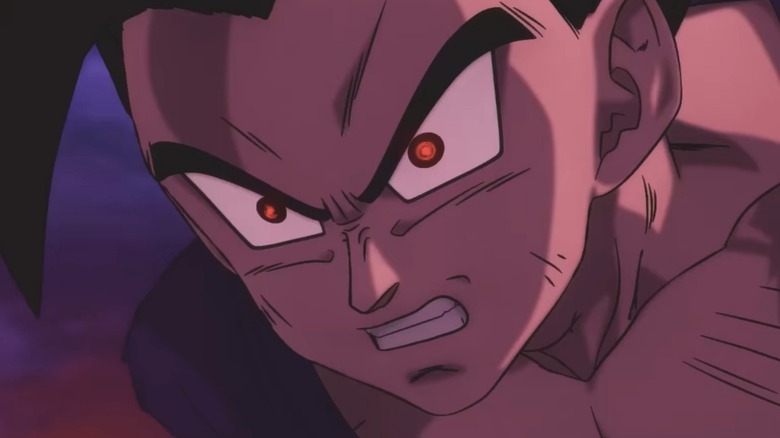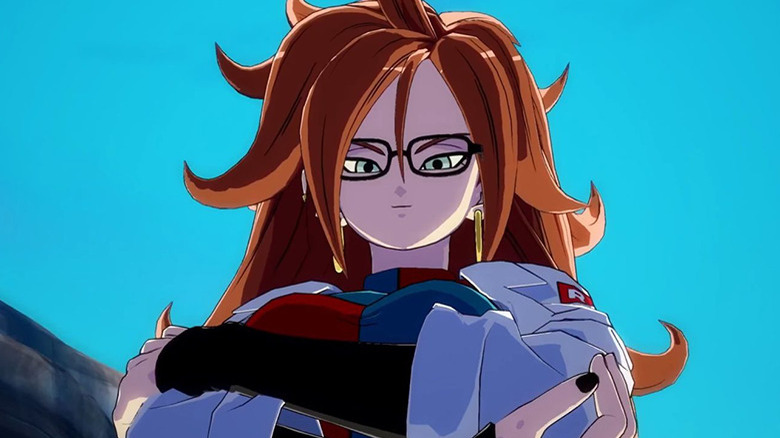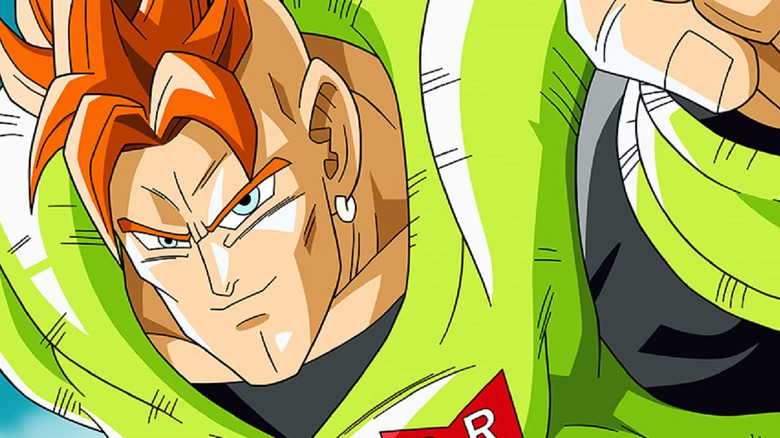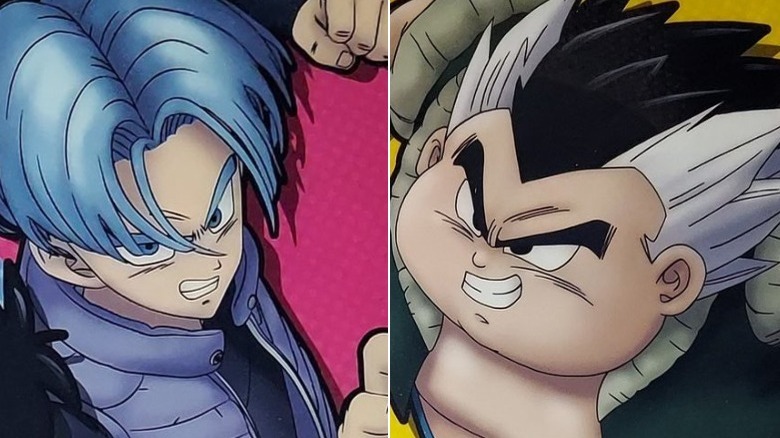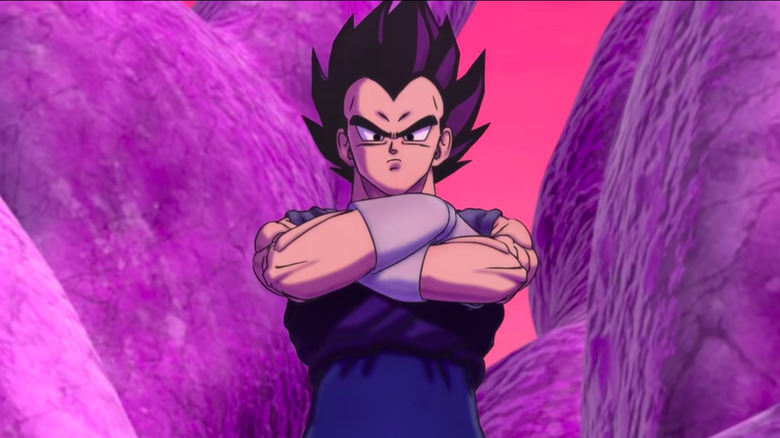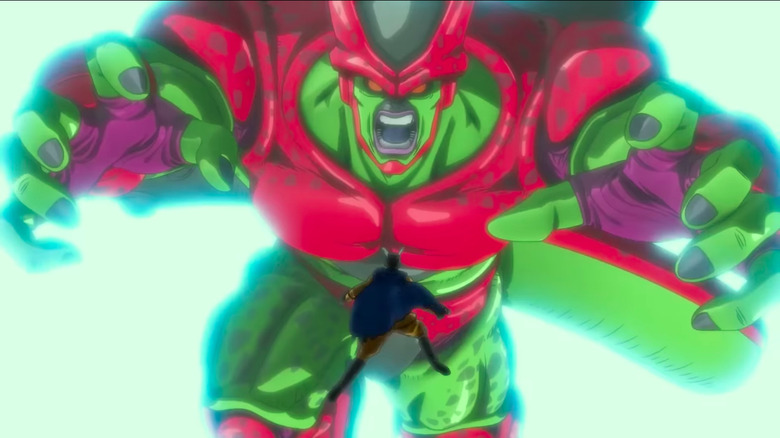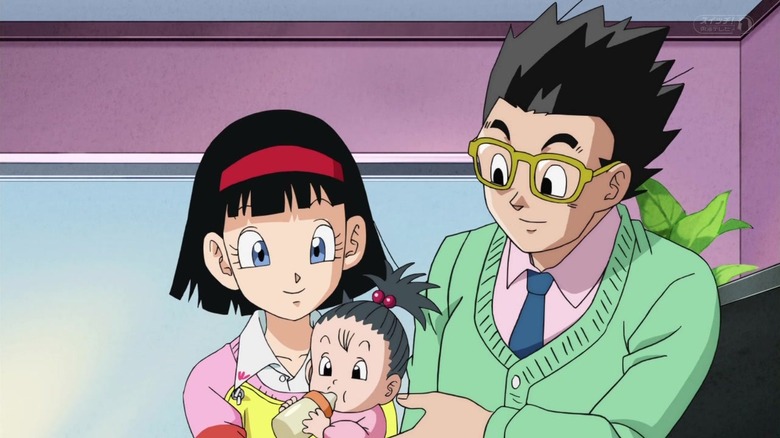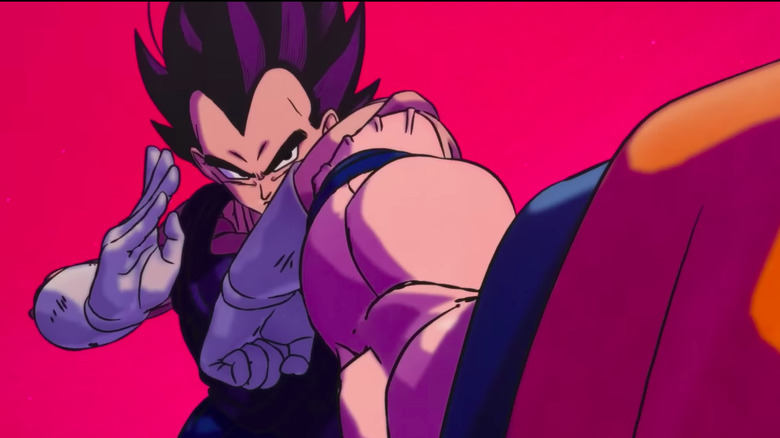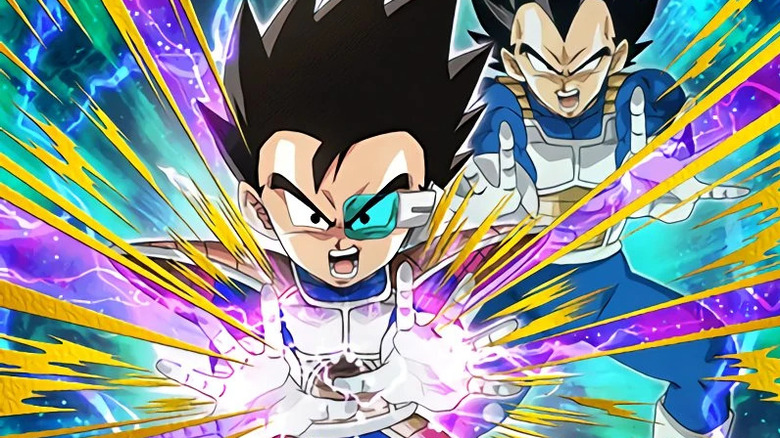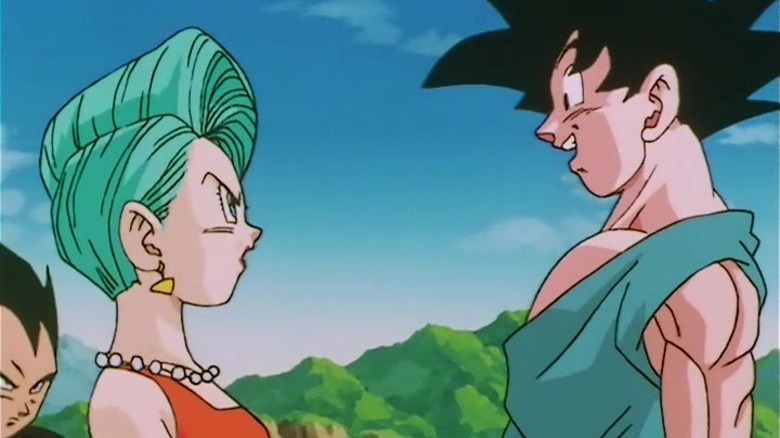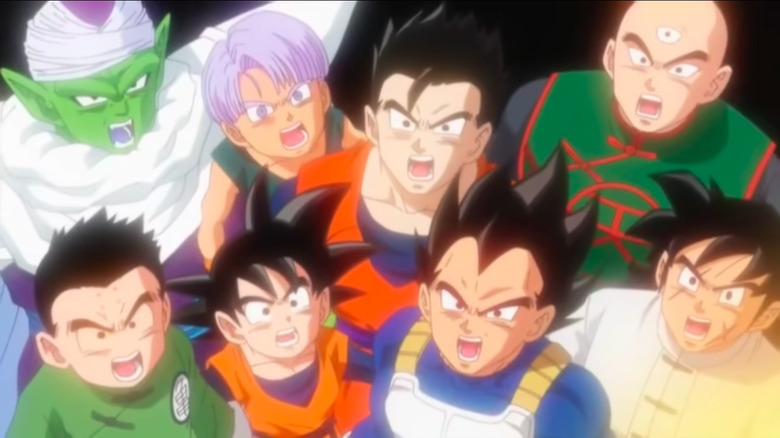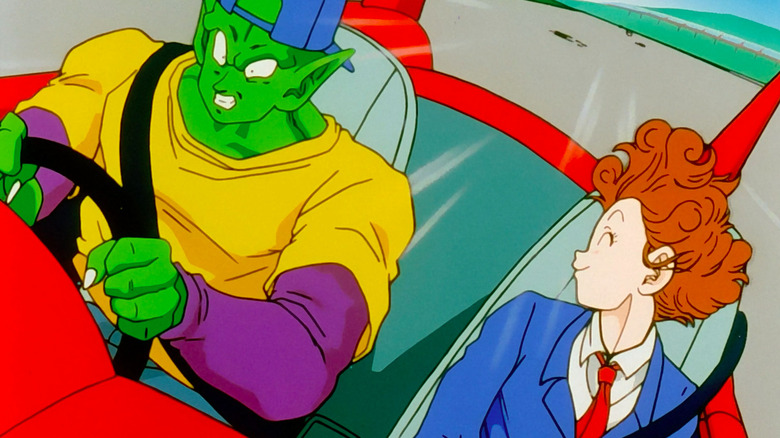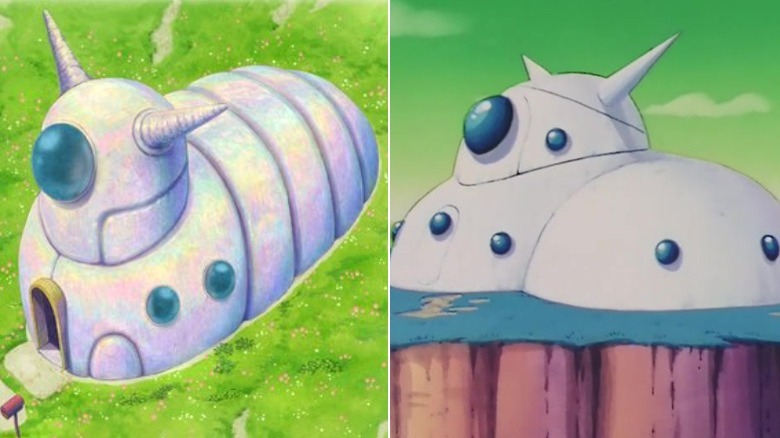Small Details You Missed In Dragon Ball Super: Super Hero
It may have taken a little longer than expected, but "Dragon Ball Super: Super Hero" is finally here. The latest feature film in the "Dragon Ball" franchise has done mighty well for itself globally on the silver screen (via Crunchyroll), and has already become one of the five most successful theatrical anime releases in the U.S. ever, first replacing "Dragon Ball Super: Broly" at #5 and, more recently, taking the place of "Jujutsu Kaisen 0" at #4. It's also notable for a number of big firsts for the "Dragon Ball" series, including being the first animated feature done entirely with CGI and the first to feature Piccolo and Pan as the main protagonists, alongside veteran "Dragon Ball" movie headliner Gohan.
If you've seen the movie, you've probably heard people talking a lot about the big stuff, like Gohan Beast and Orange Piccolo. Yet as fans of the last film, "Dragon Ball Super: Broly," can tell you, recent "Dragon Ball" movies do like to slip in a number of Easter eggs that can easily fly past a casual glance. While "Super Hero" doesn't have quite as many as "Broly," there may still be a thing or 12 that didn't catch your notice on first viewing. Set your scouter on "magnify," because it's time to spot some details you might have missed in "Dragon Ball Super: Super Hero."
Hedo's grandmother is pretty much Android 21
Introduced in the game "Dragon Ball FighterZ," Android 21 is a Bio-Android that has the strength of Earth's strongest fighters and the intellect of several research geniuses, thanks to their cells being added to her body. However, she's originally a human woman, whose son becomes the physical inspiration for Android 16. She also admits to conflicted feelings about the scientist who made her into an Android, who's implied to be the infamous Dr. Gero, aka Android 20.
That's some pretty major backstory to stick in a video game, especially given its repercussions for 16 and Gero. The game "Dragon Ball Z: Kakarot" even adds another twist by having 21's human self appear at Capsule Corporation as a researcher during Vegeta's early days living there. Yet because Android 21 originally only appears in video games, her place in the "Dragon Ball" canon remains mysterious for some time.
"Super Hero," however, finally provides something of an answer. Early on in the film, when Carmine (a fellow Android) is displaying the family tree of genius Dr. Hedo, a woman named Vomi is listed as Hedo's grandmother ... who just happens to resemble Android 21 to a tee. While it's unclear if Vomi's ever turned into a cyborg, the scene otherwise confirms her existence and pre-Android backstory as canon, and clarifies her ties to Gero: namely, that she's his spouse. The scene also confirms her stated connection to Android 16 in "FighterZ," as seen below.
Akira Toriyama's Android 16 backstory is officially canon
"Dragon Ball" creator Akira Toriyama turned quite a few heads in 2013 and 2014 when the digitally colorized version (via Kanzenshuu) of the original "Dragon Ball" manga started getting a print release. While Toriyama didn't recolor the series himself, he did provide enlightening, previously unknown tidbits about the series in the "Q&A" section of these "Dragon Ball Full Color" volumes. One that in particular got the fandom talking was his revelation that Android 16, the nature-loving robot who eventually defies his original programming, is actually based on a Red Ribbon Army soldier killed in battle – who just happens to also be Dr. Gero's son. Toriyama made a similar statement about Android 19, whose clownish appearance is inspired by a doll Gero finds in enemy territory.
The Android 16 reveal proved especially popular, even making its way into the "Dragon Ball FighterZ" video game, as mentioned earlier. Video games don't usually tend to be canon to the "Dragon Ball" universe, but — as with 21 herself — "Super Hero" confirms Gero does indeed have a son, as also seen in Dr. Hedo's family tree. Furthermore, like his mom Vomi, Gero's son is given a name, Gevo. Not only is Gevo identical to Android 16, but he is also pictured in what is clearly a Red Ribbon Army soldier's uniform, all but confirming everything Toriyama's said about him previously.
Trunks' ever-changing hair color
Trunks' hair has always been an odd case in "Dragon Ball." When his future self is introduced in the manga, his hair is purple, the reason clearly being that Bulma's hair is also purple in the manga. Yet while Bulma's hair is blue in the "Dragon Ball Z" anime, Future Trunks' hair is still purple there, as well. Oddly, however, when Future Trunks returns in "Dragon Ball Super," his hair color pulls a Bulma and also changes to blue — a decision made more unusual by the fact that his present-day self, a.k.a. Kid Trunks, is still portrayed with purple hair. Furthermore, no one in the cast mentions the hair color change, suggesting that it's only noticeable to viewers.
"Dragon Ball Super: Super Hero" makes the situation even hairier (see what we did there?) by showing Kid Trunks, now a teenager, with blue hair. Curiously, however, when he fuses with Goten to become Gotenks, that blue hair becomes purple again! Though likely all done for stylistic reasons, the intricacies behind Trunks' ever-changing hair color remain a mystery.
Vegeta's back in his Buu Saga clothes
Throughout most of "Dragon Ball Z," Vegeta wears a blue (sometimes black) jumpsuit with a white chest plate on top. While some minor details change over time, he essentially keeps this look for the majority of the series. His suit even becomes rather ubiquitous in the Cell Saga, where Bulma makes multiple copies of Vegeta's uniform for her friends to train in. Thus it's somewhat shocking when Vegeta finally leaves the ensemble behind shortly before Buu shows up, ditching the chest plate and swapping his long-sleeved jumpsuit for a sleeveless one.
By "Dragon Ball: Hey! Son Goku and Friends Return!!," however, Vegeta's back in his familiar armor and blue long-sleeve jumpsuit, which he also wears throughout "Dragon Ball Super" and in the "Battle of Gods" movie. Sure, he wears a gray-black jumpsuit in "Resurrection 'F,'" but let's be honest: it's otherwise the same outfit. So it's quite a surprise to see him back in his Buu Saga duds for "Super Hero," as teased by pre-release images. Despite being in plain sight, it's still one of those things that can go overlooked when one's wrapped up in the story, especially since Vegeta's screen time is fairly brief.
Cell Max's screams may sound familiar
"Dragon Ball Super: Super Hero" doesn't just bring back the Red Ribbon Army, but also its most terrifying creation: Cell. Well, sort of. Rather than resurrect the original version of the Bio-Android, new Red Ribbon Army leader Magenta has his brilliant ally Dr. Hedo create a fresh version, called Cell Max. There are definitely differences between the two Cells, as Max is a whole lot bigger, includes red in his color scheme and has a mace for a tail, rather than a stinger that expands into a suction cup. He also, in a first for the character, only yells, rather than speaks.
Yet those wondering if Dameon Clarke and Norio Wakamoto return to voice the character in the U.S. and Japanese versions of the movie can rest easy. As IMDb and the film's credits confirm, Clarke and Wakamoto are indeed the men behind the behemoth's roars. If you have a good ear for voices, you may have deduced that already while watching the movie. Should that have escaped your notice, however, you can now go back and rewatch "Super Hero" with a knowing smile on your face.
Gohan and Videl's jobs, revealed
Sure, Mr. Satan's earnings as purported savior of the world play their part in financially supporting Gohan, Videl and Pan — more specifically, it's his money that gets their big mansion built. Yet it hasn't always been clear what Gohan and Videl's job situation has been in the "Dragon Ball Super" era. While Gohan is often said to be a successful scholar, the exact field(s) he specializes in goes unmentioned for quite some time. Similarly, while Videl is an official protector of Satan City in her teenage years, often coordinating her efforts with the authorities, she's not said to be working in the "Dragon Ball Super" anime or manga series.
"Dragon Ball Super: Super Hero" finally clears things up a little, revealing that Videl gives classes in combat sports. Meanwhile, Gohan, at least in the film itself, is said and shown to be acting as a biologist, as he's depicted researching an insect who turns from black to gold like a Super Saiyan's hair. Whether Gohan works in other fields is unknown, but it is nice to have a better idea of what he and Videl do when they're not on big adventures or taking care of Pan.
Vegeta finally defeats Goku without either cheating
Goku and Vegeta's bouts are the stuff of "Dragon Ball" legend, so much so that Vegeta's made it a point to become Goku's fighting superior. While the two spar a lot in "Dragon Ball Super," their only two real battles are when Vegeta first comes to Earth and when Babidi turns the proud Saiyan prince into Majin Vegeta. And let's face it — neither fight is won fair and square. In their first bout, Goku gets a fair amount of help from his best friend, Krillin, and his son, Gohan, and it's the latter character who really does Vegeta in. Then in their second match, Majin Vegeta KOs Goku by tricking his rival into thinking their fight's over, then attacking from behind.
While fighting dirty is understandable in Goku's case, given how Vegeta's threatening Earth at the time, the two have long been due for a rematch. They finally get their chance in "Super Hero," where Vegeta reveals in the post-credits scene that he's finally taken the title of "champ" from Goku, so to speak. While only the beginning and the end of the fight are shown, it's pretty clear Vegeta doesn't use tricks or outside interference to win, as Whis has him and Goku battle under very strict conditions. Sure, they don't fight at full power, since Whis forbids transformations during their scrap, but Vegeta beating Goku's base form is still impressive ... even if only a small part of it happens onscreen.
No Tarble references
Poor, poor Tarble. You'd think the younger, peaceful brother of a prominent character like Vegeta would make a bigger impact. Yet he hasn't made a single appearance since the mini-movie "Dragon Ball: Hey! Son Goku and Friends Return!!"
That doesn't mean Akira Toriyama, who's credited for the short film's story, has forgotten about him, however. Bulma and Vegeta bring up the character in the film version of "Battle of Gods," though that reference is sadly nixed when the movie is adapted by the "Dragon Ball Super" TV series. Toriyama then sneaks a mention into "Dragon Ball Super: Broly," but rather unflatteringly, as Vegeta expresses total indifference when Nappa wonders aloud if Tarble is among the survivors of his planet's decimation.
Yet even if Tarble considers any press good press, he won't have any luck with "Dragon Ball Super: Super Hero," where he neither shows up on screen or in anyone's conversations. Seeing as "Resurrection 'F'" doesn't mention Tarble, either, perhaps "Super Hero" is merely a "skip" movie for the young Saiyan, and his name will come up in a future "Dragon Ball" feature. Although frankly, another onscreen appearance would be pretty nice, too.
It cleverly maintains Goku and Bulma canon
As those very familiar with "Dragon Ball Z" know, its final three episodes jump ahead by 10 years, and the series concludes with Goku flying off with Kid Buu's reincarnation, Uub. "Dragon Ball Super" is set during that 10-year gap, starting around the time Pan is born. While "Super" is still showing fans what happened in the middle of those 10 years, some details are already revealed in "Z" itself. Goku, for instance, remarks that he hasn't gone to see Bulma in five years, creating a definitive cut-off point for Goku's visits during the "Super" period.
"Super Hero," which occurs rather close to the concluding episodes of "Z," honors that factoid in the same way that it keeps Goku and Vegeta out of the fight against the Red Ribbon Army. Thanks to Beerus tossing an empty ice cream tub over the special orb on Whis' staff, Goku is completely oblivious to Bulma's attempts to reach him and her husband. That ingenious little plot twist not only gives Piccolo and Gohan the chance to save Earth instead (with the help of a few old and new friends, of course), but it also ensures that Goku doesn't travel to where Bulma is, thus keeping that continuity point intact.
Piccolo's Battle of Gods movie homage
It's what everyone is gabbing about: Gohan and Piccolo's new transformations. Yet the way they first reach these new forms in "Dragon Ball Super: Super Hero" is also worth noting. As Piccolo is falling, for instance, the background around him turns completely black, and his mind flashes back to when Shenron told him he'd added something "extra" when he increased Piccolo's strength. From there, a new power in Piccolo awakens ... and Orange Piccolo is born.
It's certainly different from how Gohan transforms later in the movie into Gohan Beast. However, fans of "Dragon Ball Super" may notice its similarities to another major movie moment: Goku's final Super Saiyan God transformation in the "Battle of Gods" movie. Like Piccolo, Goku finds himself in a moment of free fall while visions of familiar faces — in this case, Chi-Chi and his closest friends — appear in pitch blackness. It's not quite the same as Piccolo's sequence, as Goku's loved ones are frantically shouting his name, rather than reminding him of his newfound strength. Yet it's still pretty darn close, especially since those apparitions also cause Goku to change into a more powerful form.
The English dub references a famed filler episode
Like many anime adapted from manga, the original "Dragon Ball Z" television series includes a lot of content absent from the source material. For a number of fans, anything from the "Z" anime that's not in the "Dragon Ball" manga, in their view, isn't canon.
That doesn't make the anime-only parts necessarily bad, however. One notable example is the episode the U.S. dub calls "Goku's Ordeal," in which Piccolo and Goku face a challenge beyond even their great power: passing their driver's exam. It's an episode full of laughs, thanks to Goku and Piccolo's competitive nature getting the better of them. Yet while it certainly has its fans, others dismiss it due to its non-appearance in the manga.
That doesn't stop it from getting a nod in "Super Hero," however. When Piccolo is flying a Red Ribbon Army plane back to the organization's secret base, Pan observes that the Namekian's piloting skills aren't the best. In the original Japanese dialogue, Piccolo simply admits he's not a good pilot; in the U.S. dub, however, he hilariously replies that his poor piloting skills are the result of him not getting his driver's license. It's a very overt nod to "Goku's Ordeal" that'll likely get chuckles or even outright guffaws from the episode's fans. Sadly, though, since the reference is only in the U.S. dub, one can't say for sure if "Goku's Ordeal" is officially canon across all "Dragon Ball" media — at least not yet.
Piccolo's home may look familiar
Fans know that Piccolo's fond of meditating just about anywhere. But where does he sleep? Or, for that matter, live? For years, the answer seemed to vary between Kami's Lookout or just about anywhere in the wilderness that seemed comfortable at the time. "Super Hero," however, finally gives Piccolo his own home — his own house, in fact.
Those with strong memories of Namekian architecture and decor may find certain aspects of Piccolo's abode quite familiar. For one, it looks a whole lot like Guru's, which is understandable: both houses are clearly based on snails, which most other Namekians are named after (that and slugs). Take a peek inside and you may notice a chair that resembles the thrones of both Guru's and Piccolo's past self, King Piccolo. Toriyama's gone on record (via Kanzenshuu) saying that pretty much every Namekian home uses King Piccolo's seat as a reference point, and this certainly keeps with that tradition.
